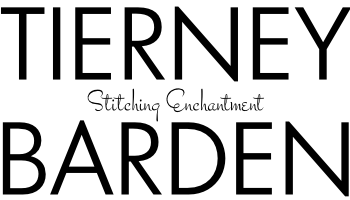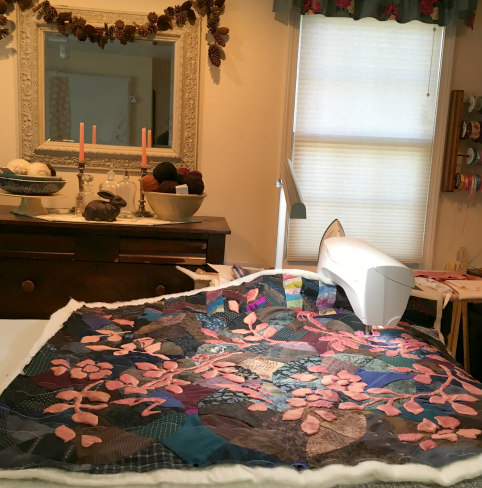Welcome to the third of four posts that look deeper into the making of my art quilts recently shown at Squam Art Workshops.
Dark Night has many layers, both physical and metaphorical, so enjoy this rare peek behind the curtain. For the complete view of "My Enchanted Wonderland" installation, please click here.
Title: Dark Night, 33.5" x 39"
Materials: Shot silk, my father's silk ties, men's cotton dress shirts, silk shantung, Japanese wovens, shot cottons, commercial cottons; wool batting
Techniques: Needle-turn applique, machine piecing, machine quilting
Date: January-February, April 2018
American Folk Art quilt, artist unknown, 1825-1845. Wool, silk, cotton, applique, beading and embroidery. Photo by Gavin Ashworth for the American Folk Art Museum.
Smitten with American Folk Art quilts, like the example shown at left, I've long wanted to make my own quilt that tells a story with hand applique figures sprinkled all over the surface. Antique folk art quilts commonly illustrated daily life on the farm, politics of the day or biblical stories; however, my quilt tells a tale that transcends time and place. The title of this quilt is a nod to a specific step of the Hero's Journey as defined by Joseph Campbell: the dark night of the soul. Making this quilt provided plenty of time to really consider what it is to be on a quest through our own dark night - the battles we fight, the choices we make along the way, whether we hold fast to our values and beliefs or perhaps discover things about ourselves that change how we see the world and ourselves. My quilt's overall design became a treasure hunt, a search for meaning, sign posts and messages that help light the way through the darkness.
As my stitched quest grew richer and more meaningful, these words eventually made their way to the surface:
Dark Night
In the depths of that dark night
Every minute of every hour
Choose love.
Shine your light. Breathe.
Trust in yourself. Believe.
One day, you'll look back
Stronger. Wiser. Softer.
-T.B.
As I mentioned, this quilt has many layers, one of which is the actual making of it. Imagine that it's February in upstate NY. Cold winds whip around the house, the days are more dark than light and temperatures hover in the teens. I'm safe in my Nest, burrowed beneath layers of downy softness, warmth and comfort, busily stitching by hand. On my right is an aged wooden bowl that holds my favorite tools and threads. Hot coffee on my night stand at 6:00AM, and by 7:00PM a fresh cup of fennel tea and a small piece of chocolate. I tell myself I've earned it, stitching by hand for 12 hours. The next day, wake up and repeat, and still with a happy heart. I realize this is the work I was meant to do. These are the stories I was meant to tell.
The background of this quilt is the traditional Flowering Snowball block. I chose that block because, like life, everything is connected. I also like how the geometry of the pattern blends both feminine and masculine energies. From around the studio I thoughtfully pulled a wide variety of fabrics, including men's dress shirts, Japanese wovens and some commercial cottons. The fabrics had to relate to the story being told, for example, a bit of black lace suggests grieving, loss, pain, sorrow, feminine energy, etc.. Where there's shadow there is light, so fabrics that brought in light were equally important, hence the gorgeous rose-gold shot silk. Including some of my dad's ties made this quilt very personal. My dad passed away of a heart attack at age 59. I was 29. This sudden and tragic loss was my first quest into my own dark night.
Hand stitching silk shantung is an indulgence I'd afford again and again. Stitching shantung into a garment is one thing, needle turn applique is another. Once I understood this fabric's tendency to fray, the nature of the weave upon turning under, and the presence of slubs, the process actually became enjoyable and I found myself drawing somewhat intricate shapes like the key, the ladder and the swan. The entire composition actually evolved over weeks of stitching, adding more paper shapes, then more stitching and more paper shapes. As I stitched, I'd connect a few more dots about dark versus light, or fighting the good fight, and another symbol would appear in my mind's eye. Gradually, all of the quilt's symbols revealed themselves. Looking back on the process, it was a good lesson in staying open and in the flow.
One of the reasons I'm partial to antique folk art quilts is their inherent wonkiness. Confronting my Type-A personality, I intentionally made myself loosen up when drawing and cutting each and every paper shape. I stopped myself from "fixing" this curve or that petal. I have to say that those wonky shapes were a joy to applique. It's funny to me that when I teach, I readily encourage students to embrace imperfection, to celebrate it, and there I was, reminding myself to do as I say. For me, those mis-shapen, odd-looking shapes breathe life into the piece. They add character and personality. The way I see it, evidence of the human hand is a gift, a little piece of the maker left behind for the viewer to discover, to take delight in and even to bond with the maker - to say, "Yes, I'm human, too." I'll have more of that, please.
Artists are often asked, "How do you know when a piece is finished?" For me, there simply comes a moment when I notice a silence in me, a stillness that says, "No more is needed. I've said all I need to say."
As always, please share your questions and comments below or by email: tierneybarden@gmail.com. I'm grateful, and I read them all. You can also follow my natural dye works and daily life on Instagram @tierneybarden.












